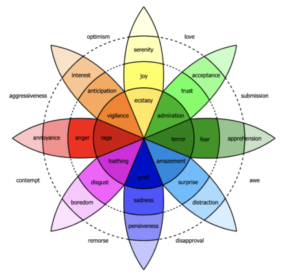Emotions can be tricky to identify.
Learning how to label your emotions is an important skill for developing strong emotional regulation – a key ability for becoming emotionally empowered.
Here’s three predominate approaches that can help you label what it is that you’re feeling.
How to Identify Your Emotions
Three approaches you can take to help you identify your emotions are explained below.
The first two approaches are response based, which require a focus on aspects of your experiential response to a strong emotion. The third approach is recollection based, which means reviewing your past memories to identify a time when you felt a similar emotion.
Action Response
The question to ask yourself: What am I doing?
Observe your actions to the emotion to gain insight on the emotion(s) you are experiencing or just experienced.
Did you ball up your fists, ready to throw a punch?
Did you yell or raise your voice?
Did your eyes well up with tears?
Did you withdraw or remove yourself from a situation (or wish that you could)?
Take note of the behaviors that you exhibited. This is also an approach that a friend or family member can help assist with, as most action responses are also observable by others.
Physiological Response
The question to ask yourself: What is my body feeling?
Observe your body’s response to the emotion to gain insight on the emotion(s) you are experiencing or just experienced.
Did your heart rate increase suddenly?
Did you experience a shortness of breath?
Did you begin to sweat?
Did a part of your body become weak – such as your legs or arms?
Did a part of your body become warm or hot – such as the face?
Did a part of your body become tense – such as your jaw?
Take note of the specific body region(s) where you noticed an obvious change from your normal (baseline) physiological state. This is an approach that requires self-awareness, which may not be natural or easy for some at first. There are electronic devices that can help measure some, but not all, of these types of responses.
Relational Recollection
The question to ask yourself: What am I remembering?
This is an excellent approach to use when more than one emotion may be at play simultaneously or when you may be experiencing “mixed feelings.”
Think of a time when you felt a similar experience.
Where were you?
What had happened?
How did you react, or, what was you response?
What was the outcome?
Assessing a similar former experience can help you better understand a current complex emotional experience.
Identify the Emotion
There are a few different models wherein the primary emotions, or basic emotions, vary.
One consistency in studies of emotions rooted in the classical view is that there are a handful of primary emotions that humans are born with, and other complex emotions, a blend of basic emotions, that develop over time. These are considered secondary emotions, which are shaped by the experience of the individual and the influence of the culture around them. Secondary emotions are classified based on their functions (social vs. moral emotions), their objects (self-oriented vs. other-oriented), and their perceived status (positive or negative).
There’s also the theory of constructed emotions. This theory posits that all mental events, including cognition, emotion, perception, and action, are shaped by allostasis, which is the process of managing the brain and body’s energy needs. (1) This idea depicts emotions not as something triggered exclusively by the outside world, but rather a combination of internal and external stimuli, along with one’s past experiences and the meanings one assigned to those experiences, as well as cultural and environmental influences.
Whichever perspective you prefer to focus on (classical vs. theory of constructed emotions), the emotions themselves are not different – merely how and why they are created. It’s interesting to note that secondary emotions in the classical view closely relate to the creation of emotions as described by the theory of constructed emotions.
Here’s a look at various emotion models over the past century.
4 basic emotion model (‘Primary Color Model’)
“Reward, punishment, and stress are the three most primitive features of the four basic emotions (happiness, sadness, fear, anger) and are driven by the three monoamine neuromodulators (DA-reward, 5-HT-punishment, NE-stress). These three monoamines are not only the substrates for the four basic emotions, but we posit that these monoamines combine in varying degrees to ultimately create various higher order emotions, much like the way different colors can be created from the three primary colors; we call this the “Three Primary Color Model of Basic Emotions.”” (2)
5 basic emotion model (‘Atlas of Emotions’)
Commissioned by the Dalai Lama, this website displays the results of over 149 scientists (emotion scientists, neuroscientists and psychologists, all of which whom were published leaders in their fields) to determine “where there was consensus about the nature of emotions, the moods or states they produce, and related areas”. (3)
The result of this survey showed that there are 5 basic emotions that are widely agreed upon by professionals in the afore mentioned fields. These 5 basic emotions are: enjoyment, fear, anger, sadness, and disgust. (4)
Compared to the 4 basic emotion model, this model includes the emotion of disgust.
The Atlas of Emotions provides a visually engaging way to learn more about emotions. View it here.
6 basic emotion model
In the 1970s, Paul Ekman and Wallace V. Friesen conducted a study on preliterate tribesman in Papau, New Guinea to determine the natural emotions that they would express, without the influence of media. This study revealed that six basic emotions were demonstrated amongst the group: anger, disgust, fear, happiness, sadness, and surprise. (5)
This model varies from the 5 basic emotion model in that it includes the emotion of surprise.
8 emotion model
In 1980, Robert Plutchik proposed an emotional model of 8 primary bipolar emotions.
These emotions are: joy vs. sadness; anger vs. fear; trust vs. disgust; and surprise vs. anticipation. Plutchik opined that these primary emotions can mix with one another to form complex emotions and can be expressed at varying intensities. (6)

This model varies from the 6 basic emotion model in that it includes the emotions of trust and anticipation.
Summary
As you can see, there’s a range of views on the subject of what constitutes our basic emotions.
The repeating theme throughout these models is that there are, in fact, lots of emotions we can experience and at the core of these emotions are a handful of identifiable emotional experiences.
Ready to change your life? Become ridiculously emotionally-empowered with the app: emotionally-empowered.com.
References
- Applying the Theory Of Constructed Emotion To Police Decision Making Fridman- Joseph- Barrett-Lisa Feldman- Wormwood- Quigley-Karen S. – https://www.frontiersin.org/articles/10.3389/fpsyg.2019.01946/full
- A Model For Basic Emotions Using Observations Of Behavior in Drosophila Gu- Simeng- Wang- Patel-James A.- Huang-Jason H. – https://www.frontiersin.org/articles/10.3389/fpsyg.2019.00781/full
- Atlas Of Emotions: Map Of Emotions Atlas of Emotions | Map of Emotions
- Ekmans’ Atlas Of Emotion Stamen Design – http://atlasofemotions.org/#introduction/
- Ekman, Paul (1989). “The argument and evidence about universals in facial expressions of emotion”. In H. Wagner & A Manstead (ed.). Handbook of social psychophysiology. Chichester, England: Wiley. pp. 143–64.
- Theories of Emotion. Plutchik, Robert., Kellerman, Henry. New York: Academic Press. 1980.
